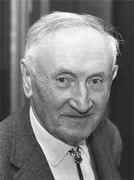Person: Zwicky, Fritz

Fritz Zwicky was a Bulgarian-born Swiss astronomer who worked most of his life in the USA. He made important contributions in theoretical and observational astronomy.
Mathematical Profile (Excerpt):
- Fritz only spent the first six years of his life in Varna for, in 1904, he was sent to Mollis, Glarus canton, Switzerland, the home of his paternal grandparents, to be educated.
- Zwicky attended primary school in Mollis and from there went to the Höhere Stadtschule in Glarus.
- After graduating from the Industry School in Zürich in 1916, Zwicky entered the Swiss Federal Institute of Technology (the Eidgenössische Technische Hochschule or simply ETH) where he switched from engineering to study mathematics and physics.
- Zwicky was also advised by Paul Scherrer (1890-1969), a student of Debye at Göttingen, who had been appointed Professor of Experimental Physics at ETH in 1920.
- Zwicky studied the applications of quantum mechanics to crystals for his Ph.D., a topic involving both physics and chemistry.
- After being awarded his Ph.D. in 1922 for his thesis On the theory of ionic crystals, Zwicky worked at ETH as a scientific assistant from 1922 to 1925.
- Zwicky is known today for his remarkable contributions to theoretical astronomy but there is no evidence of him being involved in any work related to astronomy during his studies in Switzerland.
- In 1925 Zwicky was offered such a fellowship and, since he was an avid skier and mountaineer, he asked to be posted to a position in the United States where there are mountains.
- Leaving Cherbourg, France, on the S S Lapland on 18 September 1925, Zwicky arrived in New York on 26 September en route to Pasadena.
- Once he had arrived he found that there are certainly mountains nearby, with the San Rafael Hills and the San Gabriel Mountains, but he was unimpressed with them saying that Pasadena only had "foothills." The San Gabriel Mountains, however, was the location of the Mount Wilson Observatory where Edwin Hubble was working and Zwicky began to become interested in astronomy.
- When his fellowship ended in 1929, the California Institute of Technology appointed Zwicky as an associate professor of physics, a post he was to hold until 1942.
- Let us look now at some of Zwicky's outstanding contributions.
- Baade and Zwicky also noticed that cosmic rays appeared to be associated with these objects which they called supernovae.
- Zwicky tried to explain how cosmic rays could be produced by these supernovae but failed to find anything to satisfy himself.
- In 1932 James Chadwick had discovered the neutron and soon Zwicky and Baade saw how this could solve the problem.
- Zwicky, realising that supernovae occurred very infrequently, proposed building a telescope which could photograph large numbers of galaxies in a wide-angled photograph.
- Baade stated that this was "sooner than expected!" Perhaps this was a result of Zwicky's immediate visit to Hamburg and solicitation for funding.
- Using this instrument, throughout his career Zwicky discovered 129 supernovae in distant galaxies.
- Another remarkable prediction was made by Zwicky in 1933 after studying the COMA cluster of galaxies.
- Although much of the data that Zwicky was using, such as the best estimate for the Hubble constant, was later modified considerably, nevertheless his prediction based on relatively limited statistics is now universally accepted.
- Einstein had mentioned the fact that stars could act as gravitational lenses but noted that "there is no great chance of observing this phenomenon." In 1937 Zwicky published two letters in The Physical Review.
- As with many of Zwicky's ideas, this was not followed up by astronomers for many years.
- This was five years after Zwicky's death.
- Of course anyone who was prepared to put forward ideas as freely as Zwicky will get some wrong and, indeed, this is true of him.
- Zwicky was not satisfied with this explanation and noted, correctly, that there could be other causes such as a gravitational drag, light slowly losing energy over billions of years, or even that the laws of physics could change over time.
- There is much evidence today to show that Zwicky was wrong on this topic and the expansion of the universe is real.
- Let us now look at some work that Zwicky undertook on developing rockets.
- He was joined by a number of scientists from the California Institute of Technology including Zwicky.
- For this contribution to the war effort, Zwicky was awarded the United States Medal of Freedom in 1949.
- Zwicky believed that equally important to his scientific discoveries was his method of making them which he called morphological outlook and method.
- In 1948 Zwicky delivered the Halley lecture for 1948, Morphological astronomy, at the University of Oxford.
- In 1957 Fritz Zwicky published the book Morphological astronomy.
- On the brilliant side, Zwicky was truly a "high flyer", an "outlier", who went his own way and formulated ideas and hypotheses that were ahead of their time.
- On the other side, the authors do not try to cover up the fact that Zwicky was, all too often, what we today would call a "difficult person".
- Today Zwicky has received more recognition as many of his remarkable predictions are verified.
- Asteroid 1803 Zwicky is named for him as is lunar crater Zwicky.
- Fritz classified scientists into two categories, eagles and low-fliers; a low-flier like myself recognised clearly that Fritz was the high-flier.
Born 14 February 1898, Varna, Bulgaria. Died 8 February 1974, Pasadena, California, USA.
View full biography at MacTutor
Tags relevant for this person:
Astronomy, Origin Bulgaria
Thank you to the contributors under CC BY-SA 4.0! 

- Github:
-

- non-Github:
- @J-J-O'Connor
- @E-F-Robertson
References
Adapted from other CC BY-SA 4.0 Sources:
- O’Connor, John J; Robertson, Edmund F: MacTutor History of Mathematics Archive
